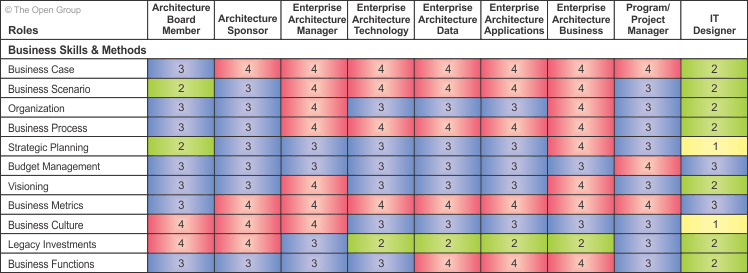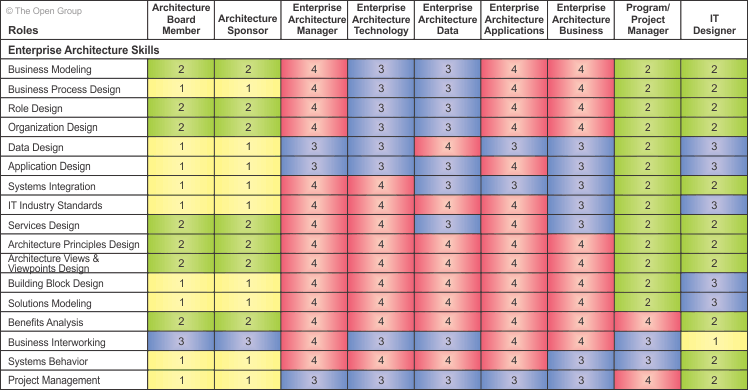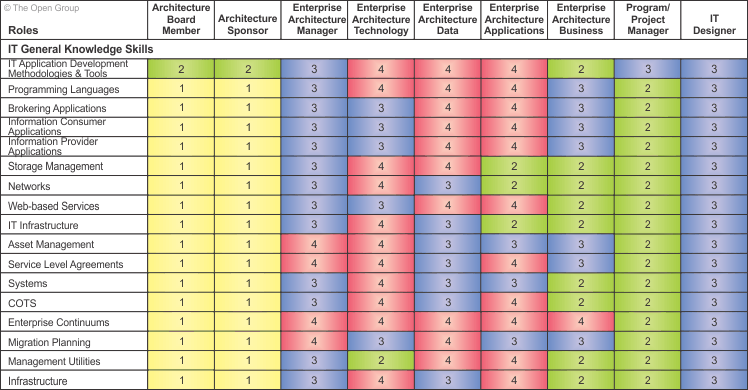
| You are here: | ||
| <<< Previous | Home | Next >>> |
This chapter provides a set of role, skill, and experience norms for staff undertaking enterprise architecture work.
Skills frameworks provide a view of the competency levels required for specific roles. They define:
They are relatively common for defining the skills required for a consultancy and/or project management assignment, to deliver a specific project or work package. They are also widely used by recruitment and search agencies to match candidates and roles.
Their value derives from their ability to provide a means of rapidly identifying skill matches and gaps. Successfully applied, they can ensure that candidates are fit for the jobs assigned to them.
Their value in the context of enterprise architecture arises from the immaturity of the enterprise architecture discipline, and the problems that arise from this.
"Enterprise Architecture" and "Enterprise Architect" are widely used but poorly defined terms in industry today. They are used to denote a variety of practices and skills applied in a wide variety of architecture domains. There is a need for better classification to enable more implicit understanding of what type of architecture/architect is being described.
This lack of uniformity leads to difficulties for organizations seeking to recruit or assign/promote staff to fill positions in the architecture field. Because of the different usages of terms, there is often misunderstanding and miscommunication between those seeking to recruit for, and those seeking to fill, the various roles of the architect.
Despite the lack of uniform terminology, architecture skills are in increasing demand, as the discipline of architecture gains increasing attention within industry.
Many enterprises have set up, or are considering setting up, an enterprise architecture practice, as a means of fostering development of the necessary skills and experience among in-house staff to undertake the various architecting tasks required by the enterprise.
An enterprise architecture practice is a formal program of development and certification, by which an enterprise formally recognizes the skills of its practicing architects, as demonstrated by their work. Such a program is essential in order to ensure the alignment of staff skills and experience with the architecture tasks that the enterprise wishes to be performed.
The role and skill definitions on which such a program needs to be based are also required, by both recruiting and supplying organizations, in cases where external personnel are to be engaged to perform architecture work (for example, as part of a consultancy engagement).
An enterprise architecture practice is both difficult and costly to set up. It is normally built around a process of peer review, and involves the time and talent of the strategic technical leadership of an enterprise. Typically it involves establishment of a peer review board, and documentation of the process, and of the requirements for internal certification. Time is also required of candidates to prepare for peer review, by creating a portfolio of their work to demonstrate their skills, experiences, and contributions to the profession.
The TOGAF Architecture Skills Framework attempts to address this need by providing definitions of the architecting skills and proficiency levels required of personnel, internal or external, who are to perform the various architecting roles defined within the TOGAF Framework.
Because of the complexity, time, and cost involved, many enterprises do not have an internal enterprise architect certification program, preferring instead to simply interview and recruit architecture staff on an ad hoc basis. There are serious risks associated with this approach:
The main purpose behind an enterprise setting up an internal enterprise architect certification program is two-fold:
Specific benefits anticipated from use of the TOGAF Architecture Skills Framework include:
This section describes the role of an enterprise architect, the fundamental skills required, and some possible disciplines in which an enterprise architect might specialize.
TOGAF delivers an enterprise architecture, and therefore requires both business and IT-trained professionals to develop the enterprise architecture.
The TOGAF Architecture Skills Framework provides a view of the competency levels for specific roles within the enterprise architecture team. The Framework defines:
The value is in providing a rapid means of identifying skills and gaps. Successfully applied, the Framework can be used as a measure for:
A typical architecture team undertaking the development of an enterprise architecture as described in TOGAF would comprise the following roles:
The tables that follow show, for each of these roles, the skills required and the desirable level of proficiency in each skill.
Of all the roles listed above, the one that needs particularly detailed analysis and definition is of course the central role of enterprise architect. As explained above, "Enterprise Architecture" and "Enterprise Architect" are terms that are very widely used but very poorly defined in industry today, denoting a wide variety of practices and skills applied in a wide variety of architecture domains. There is often confusion between the role of an architect and that of a designer or builder. Many of the skills required by an enterprise architect are also required by the designer, who delivers the solutions. While their skills are complementary, those of the designer are primarily technology focused and translate the architecture into deliverable components.
The final subsection below therefore explores in some detail the generic characteristics of the role of enterprise architect, and the key skill requirements, whatever the particular architecture domain (Enterprise Architecture, Business Architecture, Data Architecture, Application Architecture, Technology Architecture, etc.).
The TOGAF team skill set will need to include the following main categories of skills:
The tables that follow illustrate each of these categories of skills.
The tables that follow show, for each of these skills, the roles to which they are relevant and the desirable level of proficiency in each skill.
The TOGAF Architecture Skills Framework identifies four levels of knowledge or proficiency in any area:








Of all the roles listed above, the one that needs particularly detailed analysis and definition is, of course, the central role of enterprise architect. As explained above, "Enterprise Architecture" and "Enterprise Architect" are terms that are very widely used but very poorly defined in industry today, denoting a wide variety of practices and skills applied in a wide variety of architecture domains.
This section therefore explores in some detail the generic characteristics of the role of enterprise architect, and some key skill requirements, whatever the particular architecture domain (Enterprise Architecture, Business Architecture, Data Architecture, Application Architecture, Technology Architecture, etc.).
Enterprise architects are visionaries, coaches, team leaders, business-to-technical liaisons, computer scientists, and industry experts.
The following is effectively a job description for an enterprise architect:
"The architect has a responsibility for ensuring the completeness (fitness-for-purpose) of the architecture, in terms of adequately addressing all the pertinent concerns of its stakeholders; and the integrity of the architecture, in terms of connecting all the various views to each other, satisfactorily reconciling the conflicting concerns of different stakeholders, and showing the trade-offs made in so doing (as between security and performance, for example).The choice of which particular architecture views to develop is one of the key decisions that the enterprise architect has to make. The choice has to be constrained by considerations of practicality, and by the principle of fitness-for-purpose (i.e., the architecture should be developed only to the point at which it is fit-for-purpose, and not reiterated ad infinitum as an academic exercise)."
The role of the enterprise architect is more like that of a city planner than that of a building architect, and the product of the enterprise architect is more aptly characterized as a planned community (as opposed to an unconstrained urban sprawl), rather than as a well-designed building or set of buildings.
An enterprise architect does not create the technical vision of the enterprise, but has professional relationships with executives of the enterprise to gather and articulate the technical vision, and to produce the strategic plan for realizing it. This plan is always tied to the business plans of the enterprise, and design decisions are traceable to the business plan.
The strategic plan of the enterprise architect is tied to the architecture governance process (see 50. Architecture Governance) for the enterprise, so design decisions are not circumvented for tactical convenience.
The enterprise architect produces documentation of design decisions for application development teams or product implementation teams to execute.
An architect is involved in the entire process; beginning with working with the customer to understand real needs, as opposed to wants, and then throughout the process to translate those needs into capabilities verified to meet the needs. Additionally, the architect may present different models to the customer that communicate how those needs may be met, and is therefore an essential participant in the consultative selling process.
However, the architect is not the builder, and must remain at a level of abstraction necessary to ensure that they do not get in the way of practical implementation.
The following excerpt from The Art of Systems Architecting depicts this notion:
"It is the responsibility of the architect to know and concentrate on the critical few details and interfaces that really matter, and not to become overloaded with the rest."
The architect's focus is on understanding what it takes to satisfy the client, where qualitative worth is used more than quantitative measures. The architect uses more inductive skills than the deductive skills of the builder. The architect deals more with guidelines, rather than rules that builders use as a necessity.
It also must be clear that the role of an architect may be performed by an engineer. A goal of this document is to describe the role - what should be done, regardless of who is performing it.
Thus, the role of the architect can be summarized as to:
Under certain circumstances, the complexity of a solution may require additional architects to support the architecture effort. The different categories of architects are described below, but as they are architects, they all perform the tasks described above. Any combination of enterprise, enterprise solution, and solution architects may be utilized, as a team. In such cases each member may have a specific focus, if not specific roles and responsibilities, within the phases of the development process. In cases where a team of architects is deemed necessary, a lead enterprise architect should be assigned to manage and lead the team members.
An enterprise architect must be proficient in the techniques that go into producing designs of complex systems, including requirements discovery and analysis, formulation of solution context, identification of solution alternatives and their assessment, technology selection, and design configuration.
An enterprise architect should possess an extensive technical breadth through experience in the IT industry. This breadth should be in areas of application development and deployment, and in the areas of creation and maintenance of the infrastructure to support the complex application environment. Current IT environments are heterogeneous by nature, and the experienced enterprise architect will have skills across multiple platforms, including distributed systems and traditional mainframe environments. Enterprise architects will have, as a result of their careers, skills in at least one discipline that is considered to be at the level of a subject matter expert.
Enterprise architects approach their job through the consistent use of recognized design methods such as the TOGAF Architecture Development Method (ADM). Enterprise architects should have working knowledge of more than one design method and be comfortable deploying parts of methods appropriate to the situation in which they are working. This should be seen in the body of design work the enterprise architect has produced through repeated successful use of more than one design method. Proficiency in methodology use is in knowing what parts of methods to use in a given situation, and what methods not to use.
While enterprise architects are responsible for design and hand-off of the project to implementors, it is vital that they have experience with all aspects of a project from design through development, testing, implementation, and production. This scope of experience will serve to keep enterprise architects grounded in the notion of fitness-for-purpose and the practical nature of system implementation. The impact of full project scope experience should lead the enterprise architect to make better design decisions, and better inform the trade-offs made in those decisions.
Communication and team building are key to the successful role of the enterprise architect. The mix of good technical skill and the ability to lead are crucial to the job. The enterprise architect should be viewed as a leader in the enterprise by the IT organization, the clients they serve, and management.
The enterprise architect must have strong communications and relationship skills. A major task of the enterprise architect is to communicate complex technical information to all stakeholders of the project, including those who do not have a technical background. Strong negotiation and problem-solving skills are also required. The enterprise architect must work with the project management team to make decisions in a timely manner to keep projects on track.
Industry skill and experience will make the task of gathering requirements and deciding priorities easier and more effective for the enterprise architect. Enterprise architects must understand the business processes of the enterprise in which they work, and how those processes work with other peer enterprises in the industry. They should also be able to spot key trends and correct flawed processes, giving the IT organization the capability to lead the enterprise, not just respond to requests. The mission of the enterprise architect is strategic technical leadership.
The TOGAF Architecture Skills Framework provides an assessment of the skills required to deliver a successful enterprise architecture.
It is hoped that the provision of this Architecture Skills Framework will help reduce the time, cost, and risk involved in training, recruiting, and managing IT architecture professionals, and at the same time enable and encourage more organizations to institute an internal IT architecture practice, hopefully based on (or at least leveraging) the role and skill definitions provided.
return to top of page
The TOGAF document set is designed for use with frames. To navigate around the document:
Downloads of TOGAF®, an Open Group Standard, are available under license from the TOGAF information web site. The license is free to any organization wishing to use the TOGAF standard entirely for internal purposes (for example, to develop an information system architecture for use within that organization). A book is also available (in hardcopy and pdf) from The Open Group Bookstore as document G116.